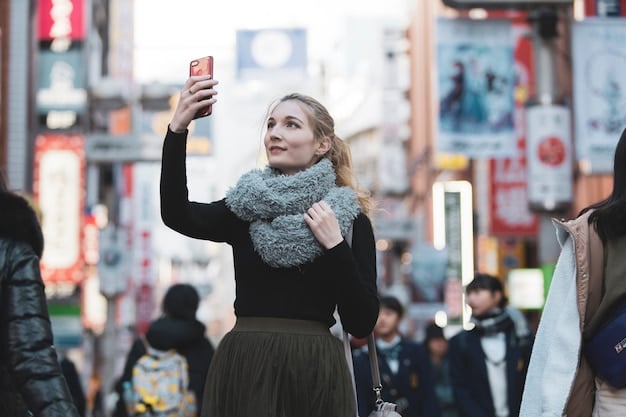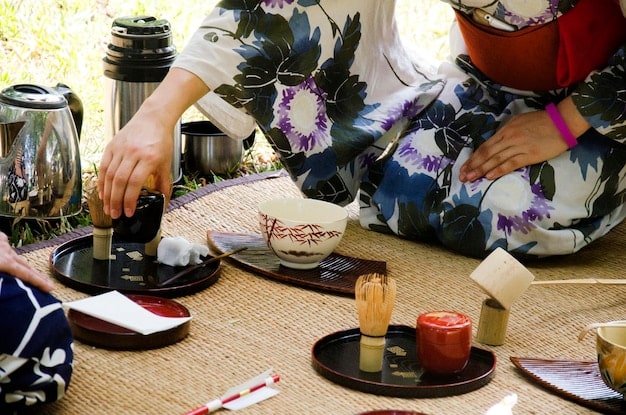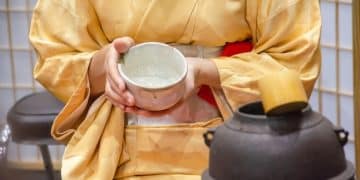Decoding Japanese Society: A Deep Dive into Cultural Nuances

Decoding Japanese Society: A Deep Dive into the Cultural Nuances of Japanese society unveils the intricate tapestry of values, traditions, and social dynamics that shape everyday life, deeply influenced by history, religion, and unique social structures.
Diving into the heart of Japan reveals a society rich in tradition and nuanced customs. Understanding these elements is key to appreciating Japanese culture and its influence on everything from art to business. Embark on a journey to decoding Japanese society: a deep dive into the cultural nuances of its fascinating people and practices.
Understanding Wa: Harmony and Social Structure
At the core of Japanese society lies the concept of wa, which translates to harmony. This principle permeates all aspects of life, emphasizing the importance of group cohesion and the avoidance of conflict.
The emphasis on wa shapes interpersonal relationships and social interactions, promoting a collectivist mindset where the needs of the group often take precedence over individual desires. It’s a cornerstone of understanding how Japanese society functions.
Group Harmony over Individual Expression
In Japan, maintaining group harmony is crucial. This emphasis affects communication styles, decision-making processes, and even personal ambitions. It’s essential to understand how this impacts social dynamics.
- Prioritizing group consensus over individual opinions.
- Avoiding direct confrontation to preserve social harmony.
- Expressing oneself subtly to avoid disrupting the group’s balance.
The principle of wa is not merely about avoiding conflict. It’s also about fostering a sense of mutual respect and understanding among individuals. This emphasis on harmony creates a cohesive social fabric.

The Importance of Hierarchy: Senpai-Kohai Relationship
Hierarchy plays a vital role in Japanese society, establishing clear lines of authority and responsibility. The senpai-kohai relationship, which translates to senior-junior, is a cornerstone of this hierarchical structure.
This system is prevalent in schools, workplaces, and even social circles, defining the roles and expectations of individuals based on their seniority and experience. The senpai-kohai relationship fosters respect and mentorship.
Mutual Respect and Guidance
In the senpai-kohai relationship, seniors (senpai) provide guidance and support to their juniors (kohai), while juniors offer respect and deference to their seniors. This dynamic creates a framework for learning and professional development.
The relationship is not just about instruction; it’s also about fostering a sense of camaraderie and loyalty. Seniors often take on a mentoring role, providing advice and support to help their juniors navigate challenges.
- Senior members guide and mentor junior members.
- Junior members respect and follow the guidance of senior members.
- This system promotes stability and continuity within organizations.
The senpai-kohai system reinforces the importance of experience and wisdom within Japanese society, creating a culture of continuous learning and mutual support.
Politeness and Etiquette: Navigating Social Interactions
Politeness and etiquette are deeply ingrained in Japanese social interactions, shaping how individuals communicate and behave in various settings. Understanding these nuances is crucial for anyone seeking to engage effectively with Japanese culture.
From bowing to using honorific language, adhering to proper etiquette is a sign of respect and consideration. These customs reflect a broader emphasis on creating harmonious relationships and avoiding causing offense.

The Art of Bowing and Verbal Deference
Bowing is a fundamental aspect of Japanese etiquette, used to express gratitude, respect, and apology. The depth of the bow conveys the level of deference or sincerity.
Verbal deference also plays a crucial role, with the use of honorific language to show respect to superiors and elders. Understanding these linguistic nuances is essential for polite interactions.
- Bowing is a primary form of expressing respect and gratitude.
- Honorific language is used to show deference to superiors.
- Gift-giving involves specific protocols to avoid social missteps.
Mastering the art of politeness and etiquette is essential for building strong relationships and fostering mutual understanding in Japanese society. It demonstrates consideration for others and enhances social harmony.
Nonverbal Communication: Reading Between the Lines
Nonverbal communication carries significant weight in Japanese society, often conveying more meaning than spoken words. Understanding these subtle cues is essential for navigating interactions effectively.
Facial expressions, body language, and even silence can communicate volumes, particularly in a culture that values indirectness and avoids direct confrontation. Being attuned to these nonverbal signals fosters deeper understanding.
The Power of Silence and Facial Cues
Silence is not merely an absence of speech in Japan. It can convey thoughtfulness, disagreement, or even polite refusal. Learning to interpret silence is a key skill.
Facial expressions, particularly micro-expressions, provide valuable insights into a person’s true feelings. Observing these subtle cues helps in reading between the lines.
Effective nonverbal communication enhances rapport and builds trust in Japanese relationships. Paying attention to these cues prevents misunderstandings and promotes harmony.
Gift-Giving Culture: Omiyage and Social Obligations
Gift-giving is an integral part of Japanese culture, representing an expression of gratitude, friendship, and social obligation. Understanding the customs and protocols associated with gift-giving is crucial.
Omiyage, or souvenirs, are commonly brought back from travels and shared with colleagues, friends, and family. This custom strengthens social bonds and fosters a sense of community.
- Gifts are seen as expressions of gratitude and respect.
- Omiyage are souvenirs shared with colleagues and friends.
- Specific protocols dictate the appropriate way to present gifts.
Engaging in the gift-giving culture demonstrates a commitment to fostering positive relationships and maintaining harmony within Japanese society. It strengthens bonds and reinforces social connections.
The Role of Tradition in Modern Life
Although Japan is a technologically advanced country, tradition continues to exert a powerful influence on modern life. Traditional values and customs permeate various aspects of society, from business practices to family dynamics.
This blending of old and new creates a unique cultural landscape, where ancient rituals coexist with cutting-edge technology. Understanding this interplay of tradition and modernity is key.
Balancing Innovation with Enduring Values
While embracing innovation, Japan remains deeply rooted in its traditions. This balance is evident in the preservation of historical sites, the continuation of traditional arts, and the reverence for ancestral customs.
The integration of traditional values into modern business practices, such as the emphasis on teamwork and long-term relationships, contributes to the success of Japanese companies. Tradition provides stability and continuity in a rapidly changing world.
Tradition enriches and shapes the fabric of modern Japanese society. Understanding this interplay is vital for truly appreciating Japanese culture.
| Key Concept | Brief Description |
|---|---|
| 🤝 Harmony (Wa) | The importance of group cohesion and avoiding conflict. |
| 🧑🤝🧑 Senpai-Kohai | Hierarchical relationship fostering mentorship and respect. |
| 礼 Politeness | Etiquette shapes communication to show respect and consideration. |
| 🎁 Gift-Giving | Represents gratitude, friendship, and social obligation. |
Frequently Asked Questions
▼
“Wa” refers to harmony and social cohesion. It emphasizes group consensus and avoiding conflict to maintain smooth interpersonal relationships in all social settings.
▼
The “senpai-kohai” system is a hierarchical relationship where senior members (senpai) mentor and guide junior members (kohai), who in turn offer respect and deference.
▼
Gift-giving expresses gratitude, strengthens relationships, and meets social obligations. It’s a way to show consideration for others and maintain social harmony through reciprocal exchanges.
▼
Nonverbal cues, such as facial expressions and body language, are vital in Japan. These signals convey intentions and meaning subtly, particularly in a culture that values indirectness.
▼
Traditions are deeply respected, with a blend of ancient rituals and modern innovation. Traditional values influence diverse aspects of life, from business ethics to familial interactions.
Conclusion
Decoding Japanese society involves understanding the intricate web of cultural nuances that shape its unique identity. From the emphasis on harmony and hierarchy to the importance of politeness and nonverbal communication, these elements provide insights into the values and customs that define Japanese culture.





